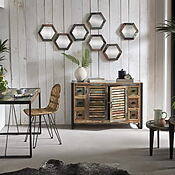It is clean lines and simple ideas that modern gardens stand out. Natural gardens that have long not been treated are very popular. They look good and are advantageous for the environment.
In current horticulture, sustainability no longer a mere catchphrase; It should be seen as a basic rule. Environmentally friendly materials and plants that save water are becoming increasingly important when designing outdoor areas. The design of terraces also attaches great importance to sustainability and multiple use. Another fascinating trend is the use of room separating components .
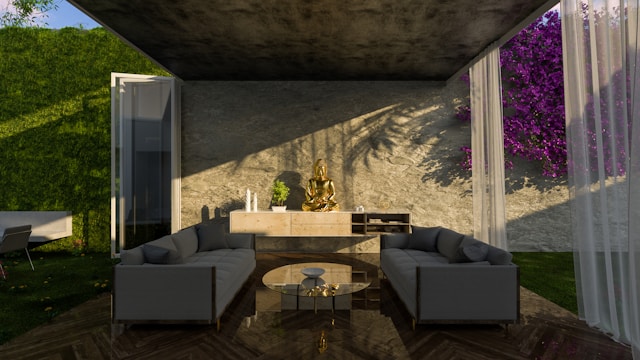
Photo by Alexander Mils @alexandermils, via Unsplash
High beds are a trendy way to cultivate your favorite flowers, fruits or vegetables in small gardens without burdening your back. These useful elements combine modern design with functionality, just like many other aspects of the contemporary landscape design, which we will take a closer look at in this article.
Design the garden and terrace as a unit
In order for the outdoor area to look as a whole, the garden and terrace have to work well together. A well -planned interaction between the living space and the surrounding area ensures a seamless transition and transforms the terrace into a green living room. Here people spend time with family and friends, have breakfast or relax after work.
It is therefore advisable to choose the furniture for outside such as the garden lounger or the terrace table in a similar style as indoors. Numerous products are available in a wide variety of explanations in specialist shops, and if the financial means corresponds, a special agreement can of course also be made at the individual request.
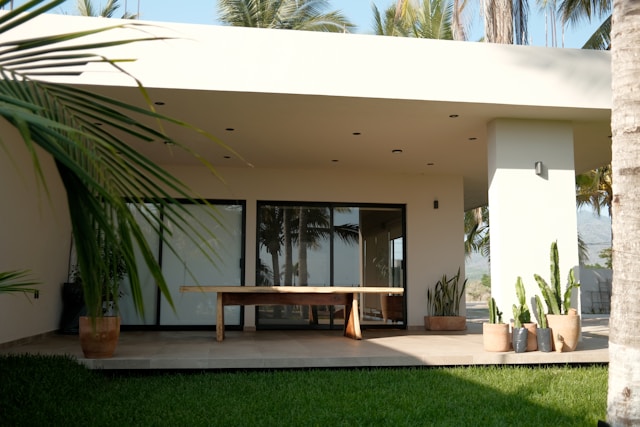
Photo by Ordan González @jorbrain, via Unsplash
But not only furniture and decoration should be chosen to match the type of design, but also ordinary everyday objects. A simple home accessory such as a vidaxl laundry basket can already be a subtle enrichment.
Design ideas for small and large areas
A clear division and organization are particularly helpful in small gardens. The idea of "size through reduction" states that modest green areas have a larger effect if they are divided smaller "garden rooms" For example, this could be a place to relax, a place to play or a covered seat. Perennial beds, high grasses or low hedges are well suited as separating elements.
Wearing paths that lead around perennial beds are ideal for long, narrow gardens because they make the area appear larger and less uniform. When flower beds and shrubs frame them, round or oval lawns make them appear larger.
If you have an extensive garden, you could ask yourself whether you should create a decorative and useful garden area with smaller areas or a spacious, park -like garden with impressive trees. A constant underlying topic is crucial so that the overall picture looks good. To keep things interesting, mix both large and small gardens as well as open and blocked visual lines.
Terrace coverings in comparison
The choice of the right terrace covering depends on style, budget and practical considerations:
- Natural stone is always elegant and lasts for a long time. No stone is like the other, regardless of whether it is granite, sandstone or porphyry. Depending on the quality and type of stone, the material costs are between 50 and 80 euros per square meter. Advantages: lasts long, is easy to walk barefoot and easy to clean. Disadvantages: it is expensive and difficult to assemble.
- Concrete slabs : Large -format plates in particular convey a feeling of calm and generosity and go well with the clear lines of modern terraces. It costs around 10 euros per square meter, which is much less than natural stone. On the other hand, special colors or artificial wood can cost up to 50 euros.
- Wooden floorboards : You let the terrace look warm and natural. When using tropical wood, you should pay attention to the FSC and PEFC seals to ensure that they come from sustainable sources. Disadvantages: The wood changes its color over time, so it often has to be cleaned.
- WPC floorboards : These composite materials made of wood and plastic look like real wood, but last longer and are more easy to care for. It takes a few months for the final color to be visible.
Use privacy screen and space divider creatively
A well -planned privacy screen not only prevents people from looking into it, but also helps to keep the garden properly and clean. Wood is a cheap and natural choice for a material. You can put ready -made fence parts together to create your own solutions and you are opaque from the start. Larch or Douglasia are two types of wood that are strong and durable.
Alternatively, plants are becoming increasingly popular as a lively privacy screen . Bamboo particularly grows quickly to visual plantings. If you want to avoid foothills, you should choose varieties of the horsely growing shieldambus (Fargesia). Evivated ivy elements also offer immediate protection.
For a harmonious overall picture, the combination of different privacy screen options is better than uniform fronts from a plant or a fence type. Views and windows in hedges, walls or fences also appear particularly exciting - they enable looks into other garden parts and at the same time create a feeling of depth and extensive.
Pay attention to weatherproof furniture and decoration
Above all, larger and heavy pieces of furniture cannot be moved easily. Then it is often hardly possible to transport them into a protected room in the cold season, especially since they also take up a lot of space. Einfache experts therefore recommend that they choose products from the start that have weatherproof properties.
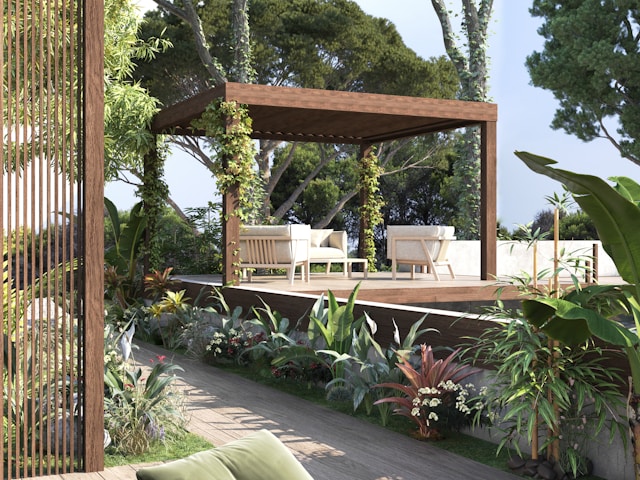
Image source: Getty Images @Gettyimages, via unsplash
Wooden furniture must have an appropriate coating in this area to prevent mold growth. Mold not only impairs the appearance but also impairs functionality and can pose a health hazard. Metal furniture and , on the other hand, can rust if they lack an appropriate coating.
When buying, it is always necessary to pay attention to weatherproof properties so that the acquired products survive the first winter. This also affects planters that are in the garden or on the terrace and should remain there all year round. Here, containers are also made of wood or modern plastics, which also convince with an appealing look.
Modern garden design with structure
The crucial elements of modern gardening are structure and order. Modern outdoor spaces focus more on the interior than on enchanting natural gardens. They feature clean lines, harmonious color schemes, and well-designed usage zones. This well-conceived concept transforms the garden into an extension of the living space and demonstrates a conscious, nature-oriented lifestyle.
Clear lines and geometric shapes
"Less is more" is the idea behind a modern garden. The use of simple forms such as squares, circles and rectangles shows that things have been reduced to the essentials. These give things a striking shape and ensure that they look neat and calm. These straight lines look great for houses from classic modernism.
The clever segmentation of the outdoor spaces makes it appear as if there were several "rooms" in the garden. For this purpose, cut hedges made of yew or hornbeam and raised beds made of bricks are excellent options. Paving strips are also useful to enter flower beds and water troughs. This arrangement results in a beautiful overall picture, but it only works if all parts are completely synchronous and in the correct proportions.
You can also use garden walls, fences or other privacy components to plan visual lines and visual axes Sculptures, ornamental fountain or resting places that catch the eye are usually at the end of these axes.
Color concepts for modern outdoor areas
Simple color schemes have become popular in today's landscape design. Many planners today use sound-in-tone combinations instead of lively diversity. Different shades of gray, together with sandy beige tones or natural wooden parts, create pictures that are calm and harmonious.
Anthracite is a color that has been very popular in recent years. This dark, elegant gray color is a powerful but neutral contrast to natural materials such as wood and stone. It looks beautiful when it is combined with green plants.
But the saying "Don't be afraid of bright colors" still applies to the current garden. Bright, warm colors such as red, yellow and orange can be used as accent points. These shades work particularly well if they are used when choosing flowering plants.
People who want to coordinate the colors from the outside and inside can also go to heaven for ideas. Heavy gray rain clouds, a stormy blue or a foggy green are all colors that fit well with the natural environment.
Material mix: wood, stone, metal
The attraction of modern garden design is often not in the material itself, but in the combination of different materials. A wooden deck with anthracite -colored aluminum railing can look as stylish as a natural stone wall with embedded metal profiles.
The following materials are preferred in a contemporary garden:
- Metal : A true all -rounder who is strong, with clear lines and precise. It can be used for fences, climbing aids, pergolas or for light shielding. Corten steel, with its rust -brown surface, really stands out.
- Wood : gives a warm and natural feeling. Hardwoods such as teak and oak as well as local woods such as larch and Douglasia are well suited for terrace boards, privacy screens and garden furniture.
- Stein : Convincing because it is strong and durable. Stone is quite useful and does not need a lot of care. It can be used as paving stones for sidewalks, natural stone walls or as decorative elements.
- Concrete : Once considered inferior, concrete is now enjoying renewed respect. Solid, simple slabs can make a patio appear vast, and they can look very different from real stone.
It is crucial that the materials are functionally coordinated and visually flee a harmonious overall picture. The combination of different textures creates exciting contrasts that make the garden alive and interesting.
Sustainable and smart: technology in the garden
Technology is increasingly finding its way into modern gardens, combining sustainability with convenience. Intelligent systems not only save valuable resources but also significantly simplify garden maintenance. With just a few adjustments, the outdoor space can be transformed into a smart oasis of well-being that blends perfectly into the overall design.
Save water with smart irrigation
Intelligent irrigation systems change the way people maintain their gardens and can reduce water consumption by up to 50%. These systems monitor things such as soil moisture, the weather and needs of the plants so that they can optimally control irrigation. The combination with the rainwater collection makes it even more sustainable.
An intelligent irrigation system consists of several components:
- Irrigation computer (from 15-20 euros for entry-level models)
- Floor moisture sensors for precise measurements
- Control units for individual irrigation zones
- Optional: solar irrigation systems for energy-sufficient operation
The cost of a complete system is between 200 and 1,000 euros. But the investment is quickly worthwhile because the plants are optimally supplied and much less water consume. An irrigation computer and one or two lawnserers are sufficient for small gardens. For larger gardens you can operate numerous irrigation zones separately.
Control lighting via app
Today's garden lighting is much more than just outside lamps. With smart LED lights you can put the mood for every occasion. Simply touch a button to transform the lights from a lively garden party into a quiet evening outdoors.
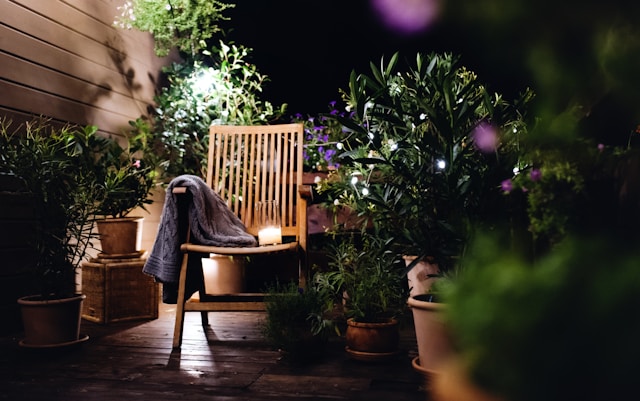
Image source: Getty Images @Gettyimages, via unsplash
First you should choose a system that meets your requirements. Most outdoor lighting systems for smart homes work with popular systems such as Google Home , Amazon Alexa and Apple Homekit . Motion detectors that turn on the light when you recognize movement are very useful. This saves energy and makes the house safer at the same time.
Make sure you check the IP protection class if you install outdoor lights because you will be exposed to wind and rain. For existing outdoor lights, it is often sufficient to exchange the light bulb for a smart. This is a cheaper option than the exchange of the entire lamp.
Use WLAN in the garden sensibly
A stable internet connection in the garden is necessary so that all smart devices work properly. Commercial routers can provide Wi-Fi signals up to 100 meters, but walls and other obstacles significantly weaken the signal.
There are four main methods to expand the WLAN network into the garden:
- Wi-Fi repeater strengthen the signal, but you can also slow down your internet connection. They work best if they are placed on doors or windows that show the garden.
- Access points connect to the router via cables, which makes the connection more robust and accelerates it. To prevent the weather from harmful to you, you should use special Ethernet connections for outdoor use when you go outside.
- A mesh network is stable and does not slow down, and it automatically connects to the strongest signal source.
- 5G/LTE router are another option because you create your own WLAN network. They are particularly useful for allotment gardens or places that have no cable connection.
Plant variety for every season
The clearest way to the universe leads through a forest wilderness. ”,,
John Muir , naturalist, author and environmental philosopher.
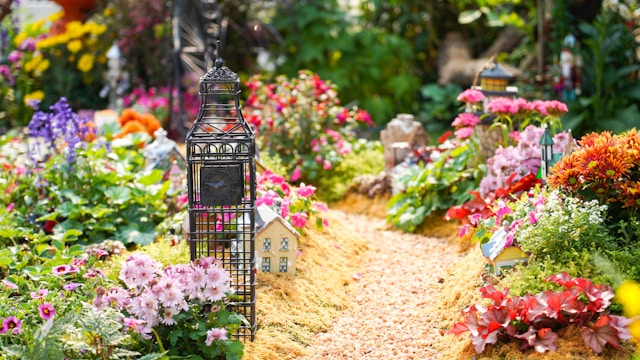
photo by man chung @cmc_sky, via unsplash
The right plants can turn their modern outdoor area into a beautiful paradise, from the first flowers of spring to the dying colors of autumn.
Plan all year round plantation
A carefully selected mix of plants that bloom at different times of year is essential for a garden that always looks beautiful. Crocuses and grape hyacinths are two early bloomers that ensure a good start to the gardening year and provide insects with their first food. In summer, cedar sage and catnip, both perennials, are the main plants. At the end of the season, miscanthus and autumn anemones bloom, showing off their petals and architecture.
When plants of the same species are in different parts of a garden, it looks particularly balanced. Use only two or three basic colors to make the overall picture appealing. Romantic mixtures such as pink, white or blue as well as lively mixtures of yellow, blue and red are very appealing.
Evergreen plants help to hold everything together and bring color into the game in the cold. They are the main component of the garden, and seasonally flowering plants complement them.
Wiesen with wildflowers that are insect -friendly
A wildflower meadow not only brings color and diversity to its landscape, but also offers insects a habitat. In certain situations, up to 30 % of the local plant species were detected on only 900 square meters.
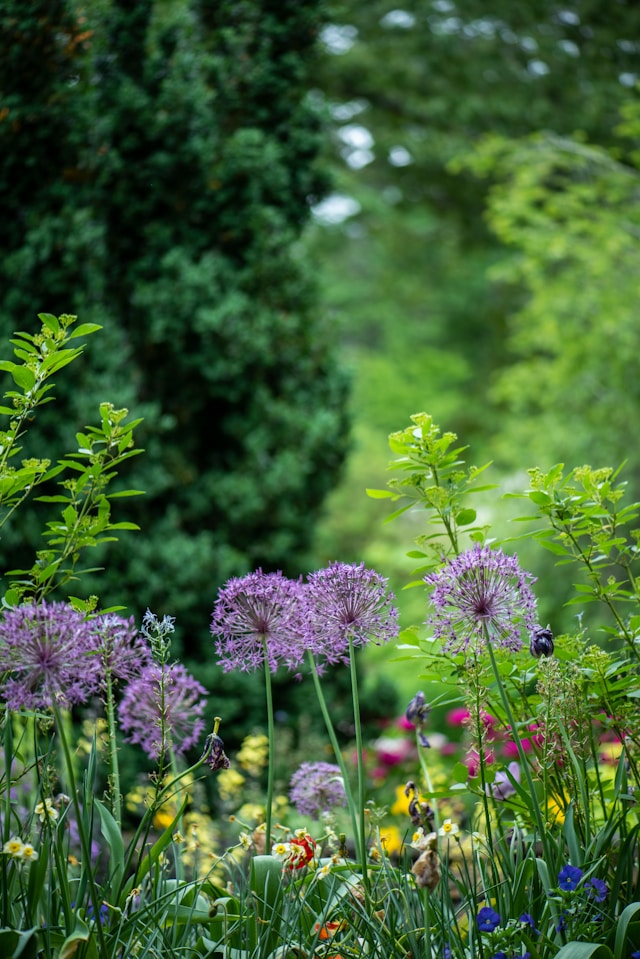
photo of Erda Estremera
@erdaest, via Unsplash
You need the following to create a flower meadow:
- Samples of local wildflowers (make sure that they are biologically grown)
- A sunny place
- Some patience. In the first year, only one -year -old plants usually bloom.
A wildflower meadow does not have to be mowed as often as a normal lawn. The best time is between July and September or twice, once at the end of June and once at the end of August.
Important: To protect bees, mow only in cloudy and cool weather.
High beds for self -sufficiency
Even in a small room, raised beds enable the cultivation of one's own fresh vegetable varieties . They facilitate care without burdening the back and offer the plants the optimal conditions to develop. A room of 25 m² is sufficient so that a person can be self -sufficient.
In a raised bed you can grow all year round:
- Spring : Dill, iceberg salad, carrots, parsley, spinach
- Summer : tomatoes, strawberries, salads
- Autumn/winter: broccoli, Chinese cabbage, Brussels sprouts
To get the best out of crop rotation , first plant strong consumers such as tomatoes or cabbage, then medium -sizeders such as onions and carrots and finally weak consumers such as radishes or lamb spinach.
The combination of crops with flowering herbs and flowers is particularly helpful. These attract useful insects that help keep the raised bed in balance. A mixed culture also ensures that the room is used optimally and prevents weeds from spreading.
Outdoor living rooms for every situation
The garden is becoming more and more like an outdoor living room (outdoor workspace) . More and more people realize that they can make their outdoor areas more useful and comfortable by adding zones that are tailored to different life situations.
Outdoor kitchen and dining area
A permanently installed or mobile outdoor kitchen enables cooking outdoors and transforms your garden into a social meeting point. Manufacturers now offer numerous design options - from the fully equipped ready -made solution to the custom -made variant. Practical elements such as a gas grill, a sink and a refrigerator form the basic equipment, while ovens, wok areas or a Plancha grille provide culinary diversity.
When choosing the material, you should pay attention to weather strength: teak, stainless steel, slate or granite are particularly suitable for the outdoor area. For a modern look, exposed concrete is also an interesting option that can now even be colored.
In addition to the kitchen itself, the dining area plays an important role. A spacious table with comfortable, weather -resistant chairs invites you to linger. Light installations and possibly integrated speakers provide an atmospheric ambience.
Garden office as a new trend
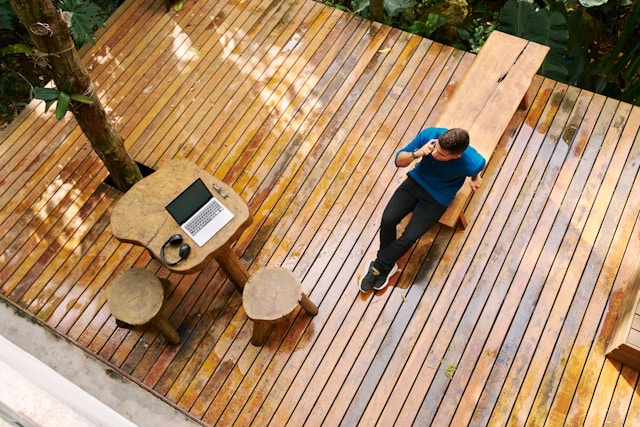
photo by Natalia Blauth @nataliablauth, via unsplash
The garden home office enables you to work hard while you are snapping fresh air and are close to nature. Garden offices have been very popular, especially since corona apandemia. It is easy to recognize the advantages: no commuting, a more balanced work-life balance and a motivating workplace.
There are several options, from a temporary workplace on the terrace to a full "Shoffice", which is a mixture of dandruff and office. If you want to work in the garden all year round, you need to pay attention to strong insulation, high-quality windows and doors as well as a steady electricity and internet supply.
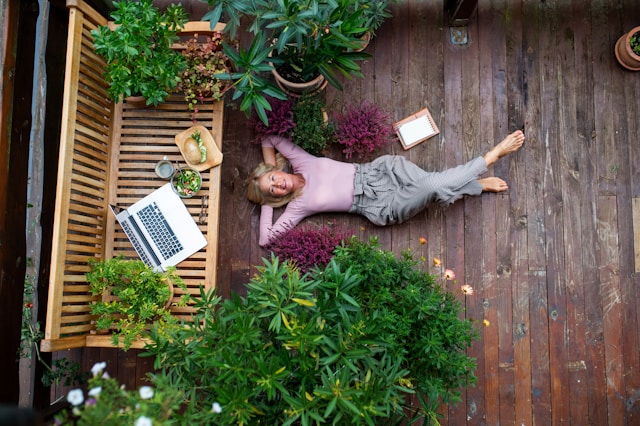
Photo by Getty Images @Gettyimages, via unsplash
Finished modules, which are available in different sizes and styles, are ideal for a modern garden office.
Child -friendly and animal -friendly design
A modern garden can be a playground for children and a home for local wild animals. Choosing the right plants is necessary for a garden that is good for animals. Local plants are the excellent pollen suppliers for bees, butterflies and other insects.
Wildflower meadows are not only great for insects, but also a captivating place for children to discover. Mow the grass only twice a year and only after the plants have formed seeds.
Small watering or flat water spots are great places for animals to cool off, and for children to have fun. Also leave "messy" corners with dead wood, leafsticks or nettles. These are great habitats for many animals.
Your modern garden - individually and functional
There are many ways to create a wellness oasis in your garden these days. You can highlight small outdoor areas by using clear lines, clever color selections and a successful combination of materials. With a few simple steps, every garden, no matter how big or small, can become a paradise.
Every garden should creatively reflect its owner's personality. So, try out a few different things to see what works for you. You should always feel at home in your green oasis.
Your garden is a place to relax to meet others and enjoy life, not just nature. Start making your outdoor environment a wellness paradise!

Owner and Managing Director of Kunstplaza. Publisher, editor and passionate blogger in the field of art, design and creativity since 2011. Successful completion of studies in web design as part of a university degree (2008). Further development of creativity techniques through courses in free drawing, expressive painting and theatre/acting. Profound knowledge of the art market through years of journalistic research and numerous collaborations with actors/institutions from art and culture.

